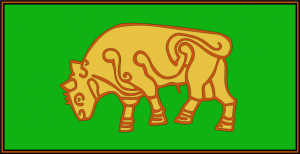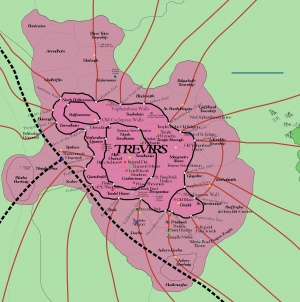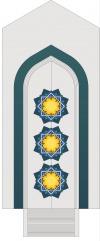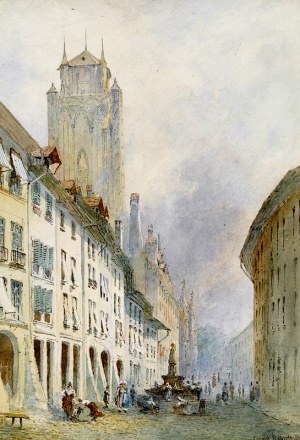Difference between revisions of "Trevirs"
Trismegistus (talk | contribs) |
Trismegistus (talk | contribs) |
||
| (13 intermediate revisions by the same user not shown) | |||
| Line 5: | Line 5: | ||
Trevirs is the most populous human city in the [[Pallathantic Region]] with 960,000 inhabitants, the fourth most populous in the old world, and heir to a past reaching back into the mists of human history. Trevirs rests atop a large prominence of hills in the [[Magdalanate]] of the [[Empire of Magdala]]. The [[Palace of the Imperial Diet of Magdala|Palace of the Imperial Diet]] rests in Trevirs. Historically, Trevirs was also the place of the Imperial Palace. The city is sometimes called Great Trevirs to distinguish it expressly from [[Royal Trevirs]]. Trevirs arose in very ancient times as a [[Kemerite Giants|Pytharnian Giant]] settlement and eventually came under control of various human tribes. Since the [[Fall of the Yophenthean Empire]], Trevirs has served as an important skyport between the western [[Jaggudorns]], [[Medibgö]], and the [[Pallathantic Region]]. Trevirs is the financial capital of southeastern [[Pytharnia]] and the seat of the headquarters of several important organizations including the [[Dwarven Dragonrail Guild of Pytharnia]] and the [[Sovereign Archguild of Master Titancrafters of Pytharnia]]. Trevirs remains the seat of the [[Palace of the Imperial Diet of Magdala]]. | Trevirs is the most populous human city in the [[Pallathantic Region]] with 960,000 inhabitants, the fourth most populous in the old world, and heir to a past reaching back into the mists of human history. Trevirs rests atop a large prominence of hills in the [[Magdalanate]] of the [[Empire of Magdala]]. The [[Palace of the Imperial Diet of Magdala|Palace of the Imperial Diet]] rests in Trevirs. Historically, Trevirs was also the place of the Imperial Palace. The city is sometimes called Great Trevirs to distinguish it expressly from [[Royal Trevirs]]. Trevirs arose in very ancient times as a [[Kemerite Giants|Pytharnian Giant]] settlement and eventually came under control of various human tribes. Since the [[Fall of the Yophenthean Empire]], Trevirs has served as an important skyport between the western [[Jaggudorns]], [[Medibgö]], and the [[Pallathantic Region]]. Trevirs is the financial capital of southeastern [[Pytharnia]] and the seat of the headquarters of several important organizations including the [[Dwarven Dragonrail Guild of Pytharnia]] and the [[Sovereign Archguild of Master Titancrafters of Pytharnia]]. Trevirs remains the seat of the [[Palace of the Imperial Diet of Magdala]]. | ||
| − | The name Trevirs derives from 'Trebhirru' the ancient Moigthe tribe who settled in the Pytharnian Highlands and subdued the remnants of the [[Neptultchi]] princes and their [[Kemerite Giant]] vassals. | + | The name Trevirs derives from 'Trebhirru' the ancient Moigthe tribe who settled in the Pytharnian Highlands and subdued the remnants of the [[Neptultchi]] princes and their [[Kemerite Giants|Kemerite Giant]] vassals. |
| Line 15: | Line 15: | ||
==Chief Sites== | ==Chief Sites== | ||
| + | ===Archbasilica of Trevirs=== | ||
| + | {{Main|Archbasilica of Trevirs}} | ||
| + | Set on the border of the High Chancel and Sewdhania so as to face the rising sun in the east, the Archbasilica of Trevirs is an Archbasilical Temple and the seat of the [[Archpatriarchy of Trevirs|Archpatriarch of Trevirs]]. The foundations of the temple are over two thousand years old. | ||
| + | |||
===Palace of the Imperial Diet=== | ===Palace of the Imperial Diet=== | ||
{{Main|Palace of the Imperial Diet of Magdala}} | {{Main|Palace of the Imperial Diet of Magdala}} | ||
| Line 32: | Line 36: | ||
==Demographics and Enclaves== | ==Demographics and Enclaves== | ||
| − | Trevirs is predominantly | + | Trevirs is an enormous city predominantly of humans with numerous enclaves communities of native [[humanlike]]s and of foreigner humans. [[Halflings]], some [[dwarves]], [[ratfolk]], a community of [[Kemerite Giants]], the rare [[elf]], and visiting [[lizardfolk]] the most frequently found humanlikes in the great metropolis. Halflings and dwarves make up the lion's share of the humanlikes. Of foreign humans, [[Jagohr]]ians, [[Thrain]]ish, [[Ambrasia]]ns, [[Gonfaloy|Gonfalese]], and [[Asbardy|Asbardians]] are the most common due to the proximity of their homelands. |
===Common Giants=== | ===Common Giants=== | ||
| − | + | Although Trevirs was originally founded in ancient times by [[Kemerite Giants]], there are few Kemerites present in the city today. They are seen almost as oddities. They have lodgings and businesses that cater to their needs. There are two enclaves of giant communities. The space for these communities is small compared to the over all size of the city and the total permanent giant population is less than three hundred. Giants are no longer mistrusted by most Trevirites and seen as a part of its rich history which is now studied by specialist scholars from the local archguild schools. Nearly all giants of Trevirs are of Kemerite extraction. There are also possibly as many as two thousand half-giants in the city. While they stick out nearly as much as their giant cousins, they have less difficulty integrating with human society. Although giants and humans have had many conflicts throughout Pytharnian history, the Kemerite giants are still regarded as native and not distrusted to the degree that other giants groups, such as the Gorcorumbese are in other parts of the world where the memory of imperial dominion lingers. | |
===Elves=== | ===Elves=== | ||
| + | {{See also|Disdrirn Elves|Relations between Disdrirn Elves and the Empire of Magdala}} | ||
Elves are rare in Trevirs as they are among humans of southern Pytharnia in general. When elves are seen, they are in groups of three or more. Often they are diplomatic entourages of ten or more, wearing hooded cloaks to hide their ears and thus conceal their elvishness. For this reason, it seems elves openly travel the streets of Trevirs more often in the winter when cloaks are common garb. There are not any known elven neighborhoods in Trevirs, except possibly for the very small community (ca 200) that supports the elven diplomatic mission in Trevirs. There is also one in Royal Trevirs. Nearly all elves in Trevirs are from the deep forests of Pytharnia. There are however notable exceptions from Sungo, usually diplomats and businessmen. The common Trevirite typically fears elves, but does not see them as a threat to his safety, unless provoked. | Elves are rare in Trevirs as they are among humans of southern Pytharnia in general. When elves are seen, they are in groups of three or more. Often they are diplomatic entourages of ten or more, wearing hooded cloaks to hide their ears and thus conceal their elvishness. For this reason, it seems elves openly travel the streets of Trevirs more often in the winter when cloaks are common garb. There are not any known elven neighborhoods in Trevirs, except possibly for the very small community (ca 200) that supports the elven diplomatic mission in Trevirs. There is also one in Royal Trevirs. Nearly all elves in Trevirs are from the deep forests of Pytharnia. There are however notable exceptions from Sungo, usually diplomats and businessmen. The common Trevirite typically fears elves, but does not see them as a threat to his safety, unless provoked. | ||
| Line 50: | Line 55: | ||
There are other humanlikes in Trevirs but most are quite rare. Lizardfolk are occasionally seen and while they draw stares, they do not cause alarm as there some imperial charter cities of the lizardfolk. The lizardfolk are typically present on government business and sometimes commerce. | There are other humanlikes in Trevirs but most are quite rare. Lizardfolk are occasionally seen and while they draw stares, they do not cause alarm as there some imperial charter cities of the lizardfolk. The lizardfolk are typically present on government business and sometimes commerce. | ||
| − | There are several tribes of [[Quirth|ratfolk]] known to make their homes in the [[Dragonneath]]. Ratfolk are often regarded as carriers of disease and filth and usually killed or taken into custody. | + | There are several tribes of [[Quirth|ratfolk]] known to make their homes in the [[Dragonneath]]. Ratfolk are often regarded as carriers of disease and filth and usually killed or taken into custody. Ratfolk are not regarded to have any civil rights. |
Centaurs are occasionally seen. They are generally mistrusted and usually harassed by the city’s gendarmes. Goblins are almost universally assaulted on sight and if not slain, then taken into custody. Any goblin with legitimate business in the city must usually be escorted by humans to avoid trouble. Ithrabbi haven’t been seen in ages and would be assaulted if they were. Orcs are nearly as dreaded as goblins, but they usually have an escort of humans or are wearing official garb to give most humans cause to restrain themselves from fright or attack. Half-orcs are uncommon but generally less disruptive to the public sensibilities. There is a small but thriving community of half-orcs, although most Trevirite half-orcs do not live in it. | Centaurs are occasionally seen. They are generally mistrusted and usually harassed by the city’s gendarmes. Goblins are almost universally assaulted on sight and if not slain, then taken into custody. Any goblin with legitimate business in the city must usually be escorted by humans to avoid trouble. Ithrabbi haven’t been seen in ages and would be assaulted if they were. Orcs are nearly as dreaded as goblins, but they usually have an escort of humans or are wearing official garb to give most humans cause to restrain themselves from fright or attack. Half-orcs are uncommon but generally less disruptive to the public sensibilities. There is a small but thriving community of half-orcs, although most Trevirite half-orcs do not live in it. | ||
| Line 91: | Line 96: | ||
*[[Arathracian Gymnasium of St. Aireánnau]] | *[[Arathracian Gymnasium of St. Aireánnau]] | ||
*[[Arathracian Gymnasium of St. Tambrigal the Pious]] | *[[Arathracian Gymnasium of St. Tambrigal the Pious]] | ||
| + | |||
| + | ===Titancrafters Guild School of Trevirs=== | ||
| + | {{Main|Titancrafters Guild School of Trevirs}} | ||
=Economy= | =Economy= | ||
| Line 96: | Line 104: | ||
=Transportation and Infrastructure= | =Transportation and Infrastructure= | ||
==Essence Servoes== | ==Essence Servoes== | ||
| + | There are five essence servo stations that provide essence for illumination and other industrial purposes. | ||
| + | |||
| + | ==Aerobarge Lines== | ||
| + | {{Main|Aerobarge Lines of Trevirs}} | ||
| + | {{See also|Aerobarge}} | ||
| + | [[File:TrevirsVista_Aerobarge_Lady.png|thumb|150px|One of the larger aerobarge vessels that serves the enormous population of modern Trevirs. Midjourney.]] | ||
| + | Trevirs was one of the earliest major cities to adopt aerobarges. There are presently eighteen aerobarge lines in service of its numerous residents. | ||
== Trevirite Under Rail == | == Trevirite Under Rail == | ||
| Line 146: | Line 161: | ||
{{Main|Great Fire of Trevirs}} | {{Main|Great Fire of Trevirs}} | ||
The Great Fire of Trevirs, 2603, changed the cityscape of in its core area and was the basis for the creation of [[Royal Trevirs]]. | The Great Fire of Trevirs, 2603, changed the cityscape of in its core area and was the basis for the creation of [[Royal Trevirs]]. | ||
| + | |||
| + | =Map= | ||
| + | [http://wiki.worldofasdar.com/PDFs/TREVIRS_%5b1inrep160feet%5d_00.pdf GREAT TREVIRS Map] ©2018 to 2022 Kraig Hausmann, All Rights Reserved | ||
=See Also= | =See Also= | ||
Latest revision as of 14:17, 28 September 2024
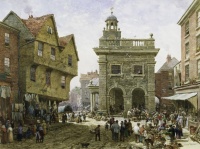
Trevirs is the most populous human city in the Pallathantic Region with 960,000 inhabitants, the fourth most populous in the old world, and heir to a past reaching back into the mists of human history. Trevirs rests atop a large prominence of hills in the Magdalanate of the Empire of Magdala. The Palace of the Imperial Diet rests in Trevirs. Historically, Trevirs was also the place of the Imperial Palace. The city is sometimes called Great Trevirs to distinguish it expressly from Royal Trevirs. Trevirs arose in very ancient times as a Pytharnian Giant settlement and eventually came under control of various human tribes. Since the Fall of the Yophenthean Empire, Trevirs has served as an important skyport between the western Jaggudorns, Medibgö, and the Pallathantic Region. Trevirs is the financial capital of southeastern Pytharnia and the seat of the headquarters of several important organizations including the Dwarven Dragonrail Guild of Pytharnia and the Sovereign Archguild of Master Titancrafters of Pytharnia. Trevirs remains the seat of the Palace of the Imperial Diet of Magdala.
The name Trevirs derives from 'Trebhirru' the ancient Moigthe tribe who settled in the Pytharnian Highlands and subdued the remnants of the Neptultchi princes and their Kemerite Giant vassals.
Geography and Situation
Trevirs rests upon the prominence of several hills in the hilly Magdalanate. Modern Trevirs includes several suburbs that meet the Yoise River which flows past the city to the north. The metropolis is in the heart of the Pytharnian Highlands at roughly 4.85 DF (610 gnö or 780m or 2560ft) above sea level. The borough of Iblatha Barrhuig rests on a prominence to the west of the historic city and has been part of the city since the late 2600's. There are four historic systems of walls or circumvallations to the city. The oldest encloses the historic center, including North Sewdhainia, High Chancel, Sewdhainia, and Caohirrimur. Nearly as old is the Bafftammon borough, also enclosed in its own wall to the northwest where it lies on a prominence of the hills. These two areas are the most ancient and their great, cyclopean walls were built by the forebears of the Kemerite Giants well over eight thousand years ago. These ancient walls have been superficially modified by later civilizations, but their core structure remains. Many millennia later during Yophenthean rule, a great circumvallation of stone was constructed farther out around the then enlarged core of the city, adding what are now North Bafftammon, Farvedhain, Swahalain, Yophenthean Quarter (Trevirs), Temple Borough, Gantahufel, Murgavain Slums, Tandel House, Throguntiac, and Citadel. The Magdisuman Wall was added in the fifteenth century to separate the Citadel Borough where the Ontigurian Kings made their residence from the rest of the interior of the city.
The air is moderately humid throughout the year with frequent rainfalls in spring and late autumn, and occasional snows through the summer. The weather is chilly in the winter and mild in the summer, with some summers verging upon hot and muggy. Due to its elevation and separation from the Pallathantic Sea by the Mathgefrew Mountains, Trevirs experiences at least two or three snows in the winter. Despite this, the Pallathantic Sea does moderate the weather of Trevirs as it does most of Pytharnia, so winter rainfall is generally more likely than snow. The presence of Lake Kasgo and Lake Thrundgally also moderate the seasonal temperatures and contribute to rainy days and snowy winters. In the winter, cold mountain breezes from the north are not uncommon. Spring brings winds from the north and the west. In the summer, winds prevail from the southwest, if at all.
Chief Sites
Archbasilica of Trevirs
Set on the border of the High Chancel and Sewdhania so as to face the rising sun in the east, the Archbasilica of Trevirs is an Archbasilical Temple and the seat of the Archpatriarch of Trevirs. The foundations of the temple are over two thousand years old.
Palace of the Imperial Diet
Tuisha Palace
Old Palace of Magdalan Royal House, in Citadel.
Palace Gonfala
In Iblatha Barrhuig.
Boroughs
Trevirs is comprised of forty two boroughs that rest both within and without the historic walls. The boroughs are based upon historic districts of the inner city, townships along the Yoise River, and adjacent barrhuigs or fortified towns atop neighboring hills for added protection to the main city of Treivrs. The boroughs are: Ackery Barrhuig, Ackery-Liocha, Annudhain, Bafftammon, Baniryoise, Belgachaib, Blacksmith, Braffergha, Caohirrimur, Citadel, Dragon Knight, Farvedhain, Gaffdiseal, Gantahufel, Gisgedine, Haiseagh, Harleagh, Heailmurgha, High Chancel, Iblatha Barrhuig, Ifosk, Kishrimmer, Lalolenda Township, Liocha, Murgavain Slums, Nirgabarrhuig, North Baftammon, North Sewdhania, Ondbriffin, River Yoise Township, Saint Aireánnau's, Saint Bambdringot's, Saint Friadora's, Scoher, Sewdhania, Sprileen, Swahalain, Tandel House, Tarrhabiaith, Temple, Throguntiac, Yophenthean Quarter. These boroughs are administrative districts based upon historic neighborhoods.
Demographics and Enclaves
Trevirs is an enormous city predominantly of humans with numerous enclaves communities of native humanlikes and of foreigner humans. Halflings, some dwarves, ratfolk, a community of Kemerite Giants, the rare elf, and visiting lizardfolk the most frequently found humanlikes in the great metropolis. Halflings and dwarves make up the lion's share of the humanlikes. Of foreign humans, Jagohrians, Thrainish, Ambrasians, Gonfalese, and Asbardians are the most common due to the proximity of their homelands.
Common Giants
Although Trevirs was originally founded in ancient times by Kemerite Giants, there are few Kemerites present in the city today. They are seen almost as oddities. They have lodgings and businesses that cater to their needs. There are two enclaves of giant communities. The space for these communities is small compared to the over all size of the city and the total permanent giant population is less than three hundred. Giants are no longer mistrusted by most Trevirites and seen as a part of its rich history which is now studied by specialist scholars from the local archguild schools. Nearly all giants of Trevirs are of Kemerite extraction. There are also possibly as many as two thousand half-giants in the city. While they stick out nearly as much as their giant cousins, they have less difficulty integrating with human society. Although giants and humans have had many conflicts throughout Pytharnian history, the Kemerite giants are still regarded as native and not distrusted to the degree that other giants groups, such as the Gorcorumbese are in other parts of the world where the memory of imperial dominion lingers.
Elves
Elves are rare in Trevirs as they are among humans of southern Pytharnia in general. When elves are seen, they are in groups of three or more. Often they are diplomatic entourages of ten or more, wearing hooded cloaks to hide their ears and thus conceal their elvishness. For this reason, it seems elves openly travel the streets of Trevirs more often in the winter when cloaks are common garb. There are not any known elven neighborhoods in Trevirs, except possibly for the very small community (ca 200) that supports the elven diplomatic mission in Trevirs. There is also one in Royal Trevirs. Nearly all elves in Trevirs are from the deep forests of Pytharnia. There are however notable exceptions from Sungo, usually diplomats and businessmen. The common Trevirite typically fears elves, but does not see them as a threat to his safety, unless provoked.
Halflings
Halflings are not an unusual sight. They have five thriving neighborhoods of various sizes in Trevirs. They are shopkeepers, crafters, entertainers, musicians, messengers, laborers, and, unsurprisingly, pickpockets. Some humans love halflings and some detest them, but most have a somewhat more balanced view. Halfling neighborhoods are downsized for the convenience of their principle occupants. However, shops facing major streets in halfling neighborhoods are usually human-sized to facilitate business among the most common inhabitants of Trevirs. Halflings are the secondmost integrated humanlike after dwarves. They are sometimes disdained as petty thieves, but not regarded as a menace to society like orcs, goblins, and ithrabbi.
Dwarves
Dwarves slightly outnumber halflings. They are industrious crafters, especially in metallurgy, tiancrafts, and are by far the most numerous employees of the Dragonrail engines, cars, garages, and administrative offices. Dwarves have only three fairly large neighborhoods, but they are found mixed in other human neighborhoods. Dwarves are the most ‘integrated’ of all the humanlike groups in Trevirs. Many dwarves are members of the Sovereign Archguild of Master Titancrafters of Pytharnia.
Other Humanlikes
There are other humanlikes in Trevirs but most are quite rare. Lizardfolk are occasionally seen and while they draw stares, they do not cause alarm as there some imperial charter cities of the lizardfolk. The lizardfolk are typically present on government business and sometimes commerce.
There are several tribes of ratfolk known to make their homes in the Dragonneath. Ratfolk are often regarded as carriers of disease and filth and usually killed or taken into custody. Ratfolk are not regarded to have any civil rights.
Centaurs are occasionally seen. They are generally mistrusted and usually harassed by the city’s gendarmes. Goblins are almost universally assaulted on sight and if not slain, then taken into custody. Any goblin with legitimate business in the city must usually be escorted by humans to avoid trouble. Ithrabbi haven’t been seen in ages and would be assaulted if they were. Orcs are nearly as dreaded as goblins, but they usually have an escort of humans or are wearing official garb to give most humans cause to restrain themselves from fright or attack. Half-orcs are uncommon but generally less disruptive to the public sensibilities. There is a small but thriving community of half-orcs, although most Trevirite half-orcs do not live in it.
Human Groups
Humans are themselves divided into numerous human ethnic groups. The most common ethnic groups are of Moigthe and Tuadbe heritage. Medibgóëse and Jagohrites are easily the most common non-Magdalan humans in the city, but there are dozens more from across the Pytharnian continent, the Pallathantic region, and even the world. Enclaves include Jagohrites, Thracians, Agogians, Ithatians, Xsytes, Amyrnites, Asbardians, Gonfalese, and Zamaclenes.
Dragonneath
Dragonneath is the informal term for the sprawling network of under-rail tunnels and associated underground tunnels and chambers beneath Trevirs. Most of the Dragonneath that is known to the public is part of the Trevirite Under-Rail. A few portions are part of ancient monastic catacombs. The sewage system at some points meets with the Trevirite Under-Rail system. However, there is an illicit portion which the authorities strive to fill in or seal up which connects to the chambers where chaos cultists are thought to convene to practice their foul religion. Despite the vigilance of the authorities, new tunnels to these places occasionally spring up. Of course, the most infamous places in Dragonneath are those associated with the headquarters and warehouses of organized crime. The Dragonneath is also the habitation of numerous Quirth tribes who give nominal obeisance to the municipal government.
Law and Government
Lord Mayor
Defenses
Culture and Festivals
Citywide Festivals
Festivals and Observances of Trevirs
Institutions of Education
Archcollege of the Yoise
Archguild School of Magitechnics at Trevirs
Archguild School of Trevirs
Archmage's College
Arathracian Gymnasia
Titancrafters Guild School of Trevirs
Economy
Transportation and Infrastructure
Essence Servoes
There are five essence servo stations that provide essence for illumination and other industrial purposes.
Aerobarge Lines
Trevirs was one of the earliest major cities to adopt aerobarges. There are presently eighteen aerobarge lines in service of its numerous residents.
Trevirite Under Rail
History
The history of what is modern Trevirs extends back into time under many peoples and names well over three thousand years.
Antediluvian Trevirs
There is no human or humanlike evidence from the antediluvian period of Trevirs according to most authorities. Our dubious knowledge of antediluvian Jhelassa is dubious at best as it is preserved in legends transmitted through different cultures.
Ancient Kemerite Giants
Jhelassa was the ancient city of Trevirs, first established by the Kemerite Giants in the eighth millennium before Salmakhamer.
Neptultchi Dominion
Early Moigthe
Late Moigthe
Yophenthean Rule
Golden Empire of Pytharnia
Llawffagainian Rule
Humanlike and Mage Rule
Rule of the Wizards Council
Rule of Kualotha of the Groaning Earth
Twelfth Isbajath and early Joint-Rule
Medibgóëse Rule
Thracian Rule
Trevirs was the seat of the Thracian Viceroyal Duke.
Magdalan Rule
Great Fire of Trevirs
The Great Fire of Trevirs, 2603, changed the cityscape of in its core area and was the basis for the creation of Royal Trevirs.
Map
GREAT TREVIRS Map ©2018 to 2022 Kraig Hausmann, All Rights Reserved
See Also
| This article is a stub. It requires further development by the creator. |
